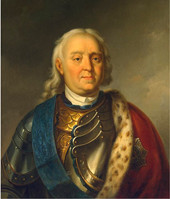
Birthday anniversary of Admiral General of the Russian Navy Fyodor Apraksin
November 27 (December 7), 1661 was born Russian statesman and military leader, general-admiral, an associate of Peter the Great, the first president of the Admiralty Board, Count Fyodor Matveyevich Apraksin.
At his service Fyodor Matveyevitch was occupied primarily with organization and development of the Russian fleet. Recorded in the Poteshny Regiment of Peter I, Apraksin was a partner of tsar during military games, accompanied him on various trips and sail in the White Sea. In 1693, Fedor Matveevich, who had been with the tsar in Arkhangelsk in the rank of steward, was appointed Dvina voivode and governor of Arkhangelsk. During his four-year management of the port, Apraksin supervised the construction of the first government merchant ship at the shipyard Solombala and its equipment with the Russian goods for sending it abroad.
In 1696 Fyodor Matveevich participated in the second Azov campaign against the Turks.
In April 1700 Apraksin was appointed the head of the Admiralty Office. His job was to supervise the newly established office, the construction of the fleet in Voronezh, organization and management of the marine part of the Azov region.
In February (March) 1707, after the death of F. A. Golovin, Apraksin was appointed admiral and president of the Admiralty. In autumn 1708 he commanded the Navy and land forces defending Ingria. For the successful defense of St. Petersburg from an attack by Swedish troops, Peter I raised him to the privy counsellor and awarded the title of a count.
In 1710 Apraksin led the passage of a 10-thousand corps over the frozen Gulf of Finland and commanded the siege of Vyborg. For the capture of the fortress Peter personally awarded Apraksin with the Order of St. Andrew and a gold sword decorated with diamonds.
In 1711, Admiral-General once again led the Azov Navy, participated in the battles, protecting the land from the Turkish attacks. The following year he commanded Estonia, Ingria and Karelia, including all of their land and naval forces.
In 1713, acting under the direct command of Peter and being at the head of galley fleet, Admiral-General won over the towns of Borgo and Helsingfors from the Swedes, having deprived the enemy from the last maneuver base in the Gulf of Finland.
July 26-27 (August 6-7), 1714 the fleet of Apraksin fought with the Swedes near the Hanko Peninsula in the Baltic Sea. Tsar also took an active part in it, having developed the battle plan. A Swedish squadron of Rear Admiral Erensheld (10 ships), locked in the bay, was attacked by Apraksin, who had given the command to go to boarding, and surrendered along with the commander.
In the years of 1715-1719 Apraksin led maritime and land operations in the Baltic, heading the Galley Fleet, participated in the landing of Russian troops on the coast of the Strait Stokzund, leading to Stockholm, and inflicted a notable defeat on the Swedes. In December 1717 he was appointed the president of the Admiralty Board and senator, and in 1718 he became the second member of the Inquiry Commission on the case of Cesarevitch Alexei Petrovich.
After the conclusion of the Treaty of Nystad with Sweden in 1721, Emperor Peter I awarded Apraksin with the Kaiser-flag authorizing him to raise it on the ship. In 1722 Fyodor Matveevich, in the rank of Commander in Chief of the Navy, accompanied Peter I in Persian campaign.
In 1726 Apraksin was appointed a member of the Supreme Privy Council.
November 10, 1728 Fyodor Matveevich Apraksin died and was buried in Moscow in Zlatoust Monastery.
In 1890’s was launched a coast defense battleship "General-Admiral Apraksin" named in honor of the distinguished statesman and naval figure.
Lit.: Адмиралы Российского флота. Россия поднимает паруса. СПб., 1995; Белавенец П. И. Генерал-адмирал Фёдор Матвеевич Апраксин. Ревель, 1899; Верх В. Н. Жизнеописание генерал-адмирала графа Фёдора Матвеевича Апраксина. СПб., 1825; Взятие Выборга // Широкорад А. Б. Северные войны России. М., 2001. Гл. 10; То же [Электронный ресурс]. URL: http://militera.lib.ru/h/shirokorad1/4_10.html; Дмитриев С. И. Генерал-адмирал граф Ф. М. Апраксин. Сподвижник Петра Великого. 1671-1728. Пг., 1914; Ковалевский Н. Ф. История государства Российского. Жизнеописания знаменитых военных деятелей XVIII — начала XX века. М., 1997; Крушение шведского нашествия // Ростунов И. И. и др. История Северной войны 1700–1721 гг. М., 1987. Гл. 3; То же [Электронный ресурс]. URL: http://militera.lib.ru/h/rostunov_ii2/03.html; Фёдор Матвеевич Апраксин: [Галерея рос. флотоводцев) // Мор. сборник. 1990. № 10.
Based on the Presidential Library’s materials:
Белавенец П. И. Генерал-адмирал граф Феодор Матвеевич Апраксин. Ревель, 1899;

